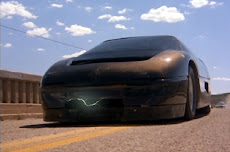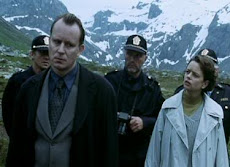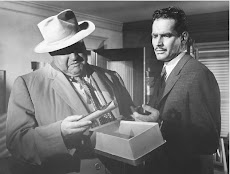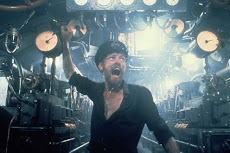I was not the first at Plymouth-Salem High School to discover The Boondock Saints around 1999. The film had a very limited theatrical release, and I don't believe Detroit or Ann Arbor fit the bill. Instead, Troy Duffy's cinematic orgy of death came to the Midwest via Blockbuster Video. With the cheaper printing of DVDs, many Blockbuster locations remain a great place to find direct-to-video trash like Cruel Intentions 3, while classics like Cool Hand Luke are only found in the online catalog.
On recommendation from the only other bona fide film buff in the tenth grade, I sought out the original and, like any 15-year-old Reservoir Dogs fan, fell in love. Vengeance, but in God's name. At the time I was impressed. Anyway, I was perhaps the second at Plymouth-Salem High School to discover Boondock Saints around 1999.
Ten years later, on the eve of the trailer for Boondock Saints 2: All Saints Day, I could officially opine "Who cares?"
Norman Reedus and Sean Patrick Flannery certainly look 10 years(+) older, and I'm sure the plot goes a long way towards explaining their prolonged absence, but it's very hard to give a vigilante story new flavor, especially in a series. The original film (like all vigilante films) plays off the worst of gut instinct: revenge. "If only someone would get these drug dealers, rapists, bartenders(?) off the streets, then things would be better." The law is not a solution to these problems, but a hindrance. Ambiguously called by the Lord to dish out a good dose of smite to the South Boston underworld, the McManus brothers (with the help of comedy well-worn with frat boys reciting "Taking your f****ing rope" for the past decade) proceed to "kill everyone." And, with their silly sidekick, a cat.
This kind of treatment can only stay fresh for so long. Rather than recognize the calamity that is sure to follow in any instance of prolonged vigilantism (that is, the collapse of the rule of law), the Saints are elevated to folk heroes-- the people we all wish we had the "guts" to be. Perhaps the sequel will add something new to the equation but, as deceiving as trailers may be in some cases, this doesn't appear to be such a case.
The two best films on vigilantism are Death Wish (1974) and Taxi Driver (1976). Both Paul Kersey (Charles Bronson) and Travis Bickle (Robert De Niro) are sociopaths, and the films take an honest approach to the derangement that leads to vigilantism and the lasting effects of such behavior. The four Death Wish sequels should serve enough of a warning to Troy Duffy to leave his original cult classic alone, but given that Duffy was actually let behind a camera again to begin with, we can't exactly expect him to branch out at this point.
Perhaps the hardest part for me is the illusion Boondock Saints projects like select other Hollywood films (such as Fight Club) that there's something clever or thought-provoking behind the story. There isn't. Unfortunately, references to God (and Marx) seem to have that effect of "Man, it just makes you think, you know?" Thinking about actually studying either subject? Fat chance. But maybe someday. Here's hoping.
I close with a little self-pat-on-the back for my previous post on the utter farce that is the Saw series. Sure enough, while I have only seen the first installment, the advertising for the sixth (!) film confirms just how simple-minded this pseudo-philosophical dirt really is:

Mindless entertainment indeed.
On recommendation from the only other bona fide film buff in the tenth grade, I sought out the original and, like any 15-year-old Reservoir Dogs fan, fell in love. Vengeance, but in God's name. At the time I was impressed. Anyway, I was perhaps the second at Plymouth-Salem High School to discover Boondock Saints around 1999.
Ten years later, on the eve of the trailer for Boondock Saints 2: All Saints Day, I could officially opine "Who cares?"
Norman Reedus and Sean Patrick Flannery certainly look 10 years(+) older, and I'm sure the plot goes a long way towards explaining their prolonged absence, but it's very hard to give a vigilante story new flavor, especially in a series. The original film (like all vigilante films) plays off the worst of gut instinct: revenge. "If only someone would get these drug dealers, rapists, bartenders(?) off the streets, then things would be better." The law is not a solution to these problems, but a hindrance. Ambiguously called by the Lord to dish out a good dose of smite to the South Boston underworld, the McManus brothers (with the help of comedy well-worn with frat boys reciting "Taking your f****ing rope" for the past decade) proceed to "kill everyone." And, with their silly sidekick, a cat.
This kind of treatment can only stay fresh for so long. Rather than recognize the calamity that is sure to follow in any instance of prolonged vigilantism (that is, the collapse of the rule of law), the Saints are elevated to folk heroes-- the people we all wish we had the "guts" to be. Perhaps the sequel will add something new to the equation but, as deceiving as trailers may be in some cases, this doesn't appear to be such a case.
The two best films on vigilantism are Death Wish (1974) and Taxi Driver (1976). Both Paul Kersey (Charles Bronson) and Travis Bickle (Robert De Niro) are sociopaths, and the films take an honest approach to the derangement that leads to vigilantism and the lasting effects of such behavior. The four Death Wish sequels should serve enough of a warning to Troy Duffy to leave his original cult classic alone, but given that Duffy was actually let behind a camera again to begin with, we can't exactly expect him to branch out at this point.
Perhaps the hardest part for me is the illusion Boondock Saints projects like select other Hollywood films (such as Fight Club) that there's something clever or thought-provoking behind the story. There isn't. Unfortunately, references to God (and Marx) seem to have that effect of "Man, it just makes you think, you know?" Thinking about actually studying either subject? Fat chance. But maybe someday. Here's hoping.
I close with a little self-pat-on-the back for my previous post on the utter farce that is the Saw series. Sure enough, while I have only seen the first installment, the advertising for the sixth (!) film confirms just how simple-minded this pseudo-philosophical dirt really is:

Mindless entertainment indeed.



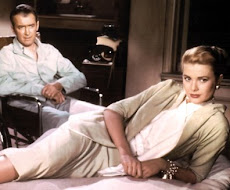_01.jpg)





